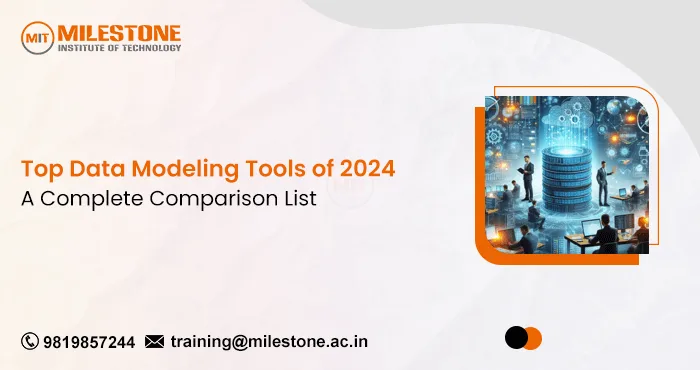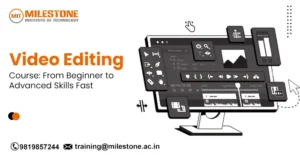Data modeling is becoming an essential factor in data analytics as well as data science which helps many different businesses to analyze, structure, and utilize the data more effectively. Due to the huge amount of raw data which has high complexity, it is crucial to use the right data modeling tools for business growth and success. In this complete blog, we will be exploring the
top essential data modeling tools of 2024, with detailed comparison for making quality decisions.
Importance of Data Modeling in Data Science
The process of producing a visual representation of data structures, which is typically done through the use of flowcharts or diagrams, is known as data modeling. The purpose of data modeling is to specify how data is stored, managed, and utilized within an organization. In
data science, data modeling plays a pivotal role in ensuring that data is accurately captured, processed, and analyzed. Here’s why data modeling is so important:
Structured Data Management
Data modeling provides a structured framework for organizing data, making it easier to manage, retrieve, and analyze. By defining the relationships between different data entities, data modeling helps in creating a cohesive data architecture.
Enhanced Data Quality
Proper data modeling ensures consistency and accuracy across the database. It helps in eliminating redundancies and anomalies, leading to improved data quality and reliability.
Efficient Data Integration
Data modeling facilitates seamless data integration from various sources, enabling a unified view of information. This is particularly important in today’s environment, where data is collected from multiple platforms and devices.
Improved Decision-Making
With a clear and structured data model, organizations can make more informed decisions based on accurate and comprehensive data. Data modeling enables the identification of key patterns and trends, providing valuable insights for strategic planning.
Scalability and Flexibility
A well-designed data model is scalable and flexible, allowing organizations to adapt to changing data requirements without disrupting existing systems. This ensures that the data infrastructure can grow along with the business.
Top Tools Used For Data Modeling
There are many tools which are available for data modeling but when it comes to choosing the right tool for your project and organization, choosing the best one is essential. Some of the top data modeling tools of 2024 are mentioned below with their features, pros, and cons, along with who they are ideal for.
ERwin Data Modeler (Paid)
ERwin Data Modeler by Quest is a highly regarded tool known for its comprehensive features, supporting both relational and NoSQL databases. It offers robust data governance integration, making it ideal for enterprise-level projects.
Key Features:
- Data governance integration
- Collaboration capabilities
- Visual interface with drag-and-drop functionality
Pros:
- Strong support for a broad variety of database types
- Excellent collaboration features for teams
- Scalable for projects of various sizes
Cons:
- Can be expensive, especially for small teams or individual users
- May require additional plugins for full functionality
Ideal for:
Teams needing a collaborative and scalable data modeling tool, suitable for both small and large projects.
Oracle SQL Developer Data Modeler (Free)
Oracle SQL Developer Data Modeler is a free tool from Oracle designed for comprehensive data modeling and database design. It supports logical, relational, and physical data modeling and is seamlessly integrated with Oracle databases.
Key Features:
- Multi-dimensional modeling
- Forward and reverse engineering
- Extensive support for Oracle databases
Pros:
- Free and accessible to Oracle users
- Strong integration with Oracle products
- Advanced modeling capabilities for complex databases
Cons:
- Limited features compared to premium tools
- Best suited for Oracle environments
Ideal for:
Oracle database users seeking a robust and free data modeling tool.
SAP PowerDesigner (Paid)
SAP PowerDesigner tool is a highly effective tool that was developed for the purpose of business architectural modeling, data integration, and metadata management. It excels in managing complex data environments with a strong emphasis on impact analysis.
Key Features:
- Enterprise architecture modeling
- Impact analysis
- Metadata management
Pros:
- Excellent for large-scale data architecture
- Robust integration with SAP products
- Strong impact analysis and reporting features
Cons:
- Costly with pricing maybe unaffordable for smaller companies
- A steep learning curve as a result of its extensive feature set
Ideal for:
Large enterprises with complex data architecture needs, particularly those using SAP products.
IBM InfoSphere Data Architect (Paid)
IBM InfoSphere Data Architect is an enterprise-grade tool focusing on data governance, quality, and integration. It is a part of IBM’s extensive suite of data management tools.
Key Features:
- Data governance and quality management
- Integration with IBM’s suite of tools
- Automated data modeling
Pros:
- High-level integration with IBM products
- Strong emphasis on data governance and quality
- Scalable for large enterprises
Cons:
- Expensive and complex, requiring significant training
- May be overkill for smaller organizations
Ideal for:
Large organizations already using IBM products with a focus on data governance.
MySQL Workbench (Free)
MySQL Workbench is a free integrated tool which is designed for development, administration, and database design. It is particularly popular for its ease of use and strong support for MySQL databases.
Key Features:
- Visual data modeling
- Database design and administration
- Forward and reverse engineering
Pros:
- Free and user-friendly
- Strong support for MySQL databases
- Comprehensive features for database management
Cons:
- Limited to MySQL environments
- Fewer advanced features compared to paid tools
Ideal for:
Users working with MySQL databases who need a free, robust data modeling tool.
ER/Studio (Paid)
ER/Studio by IDERA is a comprehensive data modeling tool that provides robust support for both logical and physical data modeling, along with powerful reporting and collaboration tools.
Key Features:
- Data lineage tracking
- Collaboration features
- Integration with multiple databases
Pros:
- Comprehensive reporting capabilities
- Strong support for enterprise-level data governance
- User-friendly with a visual interface
Cons:
- Higher cost compared to other tools
- There may be a learning curve that new users are need to go through.
Ideal for:
Large enterprises looking for an all-in-one data modeling solution with strong governance and collaboration features.
Lucidchart (Paid with Free Tier)
Lucidchart is an intuitive, web-based diagramming tool that also offers data modeling capabilities. It is particularly favored for its easy-to-use interface and real-time collaboration features.
Key Features:
- Real-time collaboration
- Customizable templates
- Cloud-based accessibility
Pros:
- Easy to use with a drag-and-drop interface
- Supports real-time collaboration, making it great for team projects
- Cloud-based, accessible from anywhere
Cons:
- Limited features in the free version
- Not as robust as specialized data modeling tools
Ideal for:
Small teams and individuals who need a simple, collaborative tool for basic data modeling tasks.
Learn Data Modeling Tools
If you’re looking to master data modeling tools, the Milestone Institute of Technology offers comprehensive
Data Science and Data Analytics Course tailored to your needs. With expert instructors and hands-on training, you’ll learn the essential skills and techniques which we help you in your successful career.
Frequently Asked Questions
How do logical and physical data modeling tools differ from each other?
Logical data modeling defines entities, properties, and relationships abstractly, therefore designing the database without regard to the actual database implementation. Physical data modeling, on the other hand, translates the logical design into a physical structure, considering aspects like indexing, storage, and database performance.
Can I use multiple data modeling tools for a single project?
Yes, many organizations use multiple data modeling tools to leverage the strengths of each tool. For example, one tool might be better for initial design, while another might excel at integration or reporting. However, it’s important to ensure compatibility and integration between the tools used.
How to choose the right data modeling tools for a project and organization?
Choosing the right data modeling tool depends on several factors, including the complexity of your data, the size of your organization, your budget, and your specific needs (e.g., data governance, integration, scalability). It’s often helpful to start with a tool that offers a free trial or demo to assess its suitability.
What skills do I need to learn data modeling?
To learn data modeling, you should have a basic understanding of database concepts, including relational databases, SQL, and data structures. Analytical skills, attention to detail, and familiarity with data governance principles are also important. Many data modeling tools offer user-friendly interfaces, but a technical background can be beneficial for more advanced modeling tasks.
How long does it take to become proficient in data modeling?
The time it takes to become proficient in data modeling varies depending on your prior experience and the complexity of the tools you’re using. For beginners, it might take several months of consistent practice and learning to become comfortable with basic data modeling tasks. For more advanced proficiency, especially in complex environments, it might take a year or more of focused study and experience.




